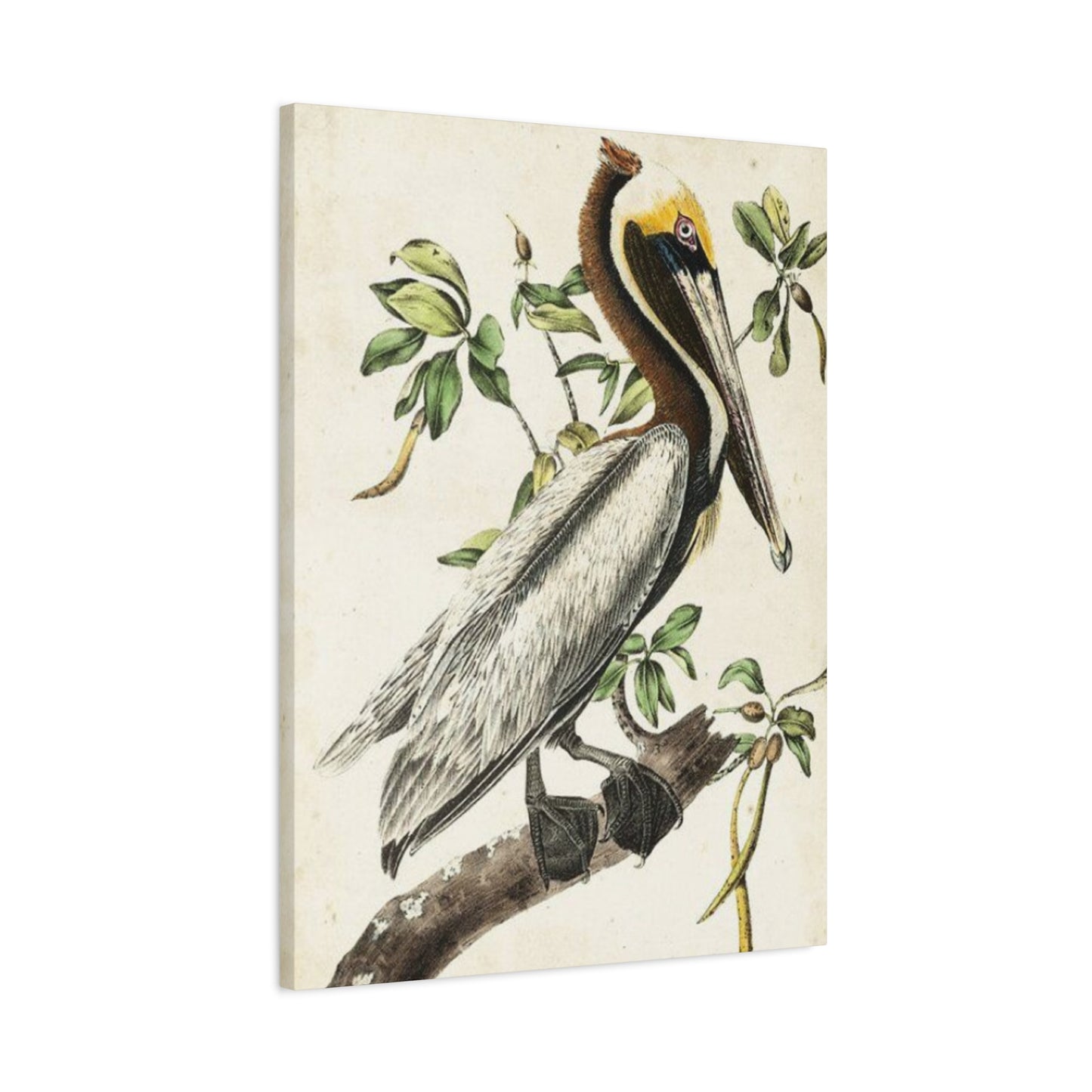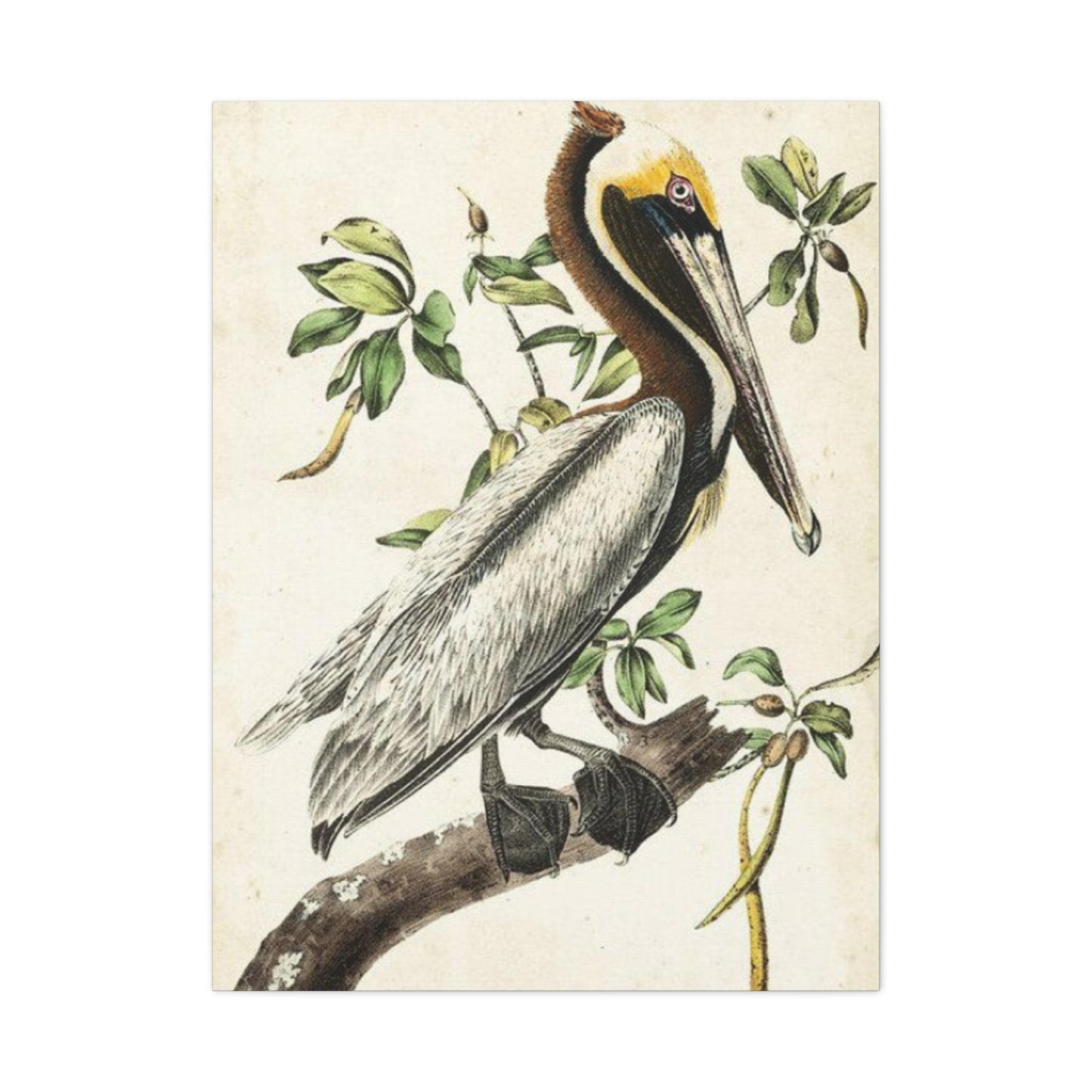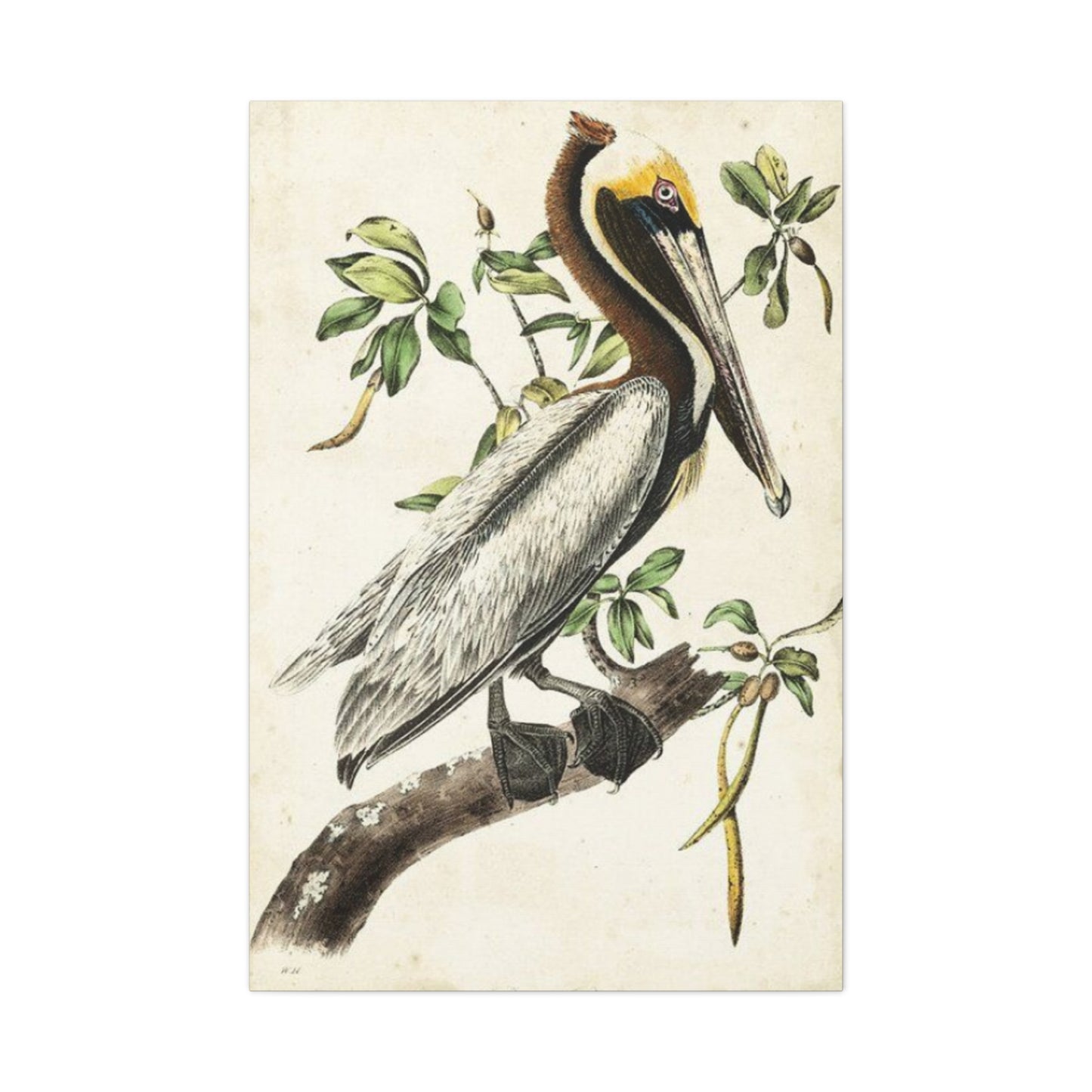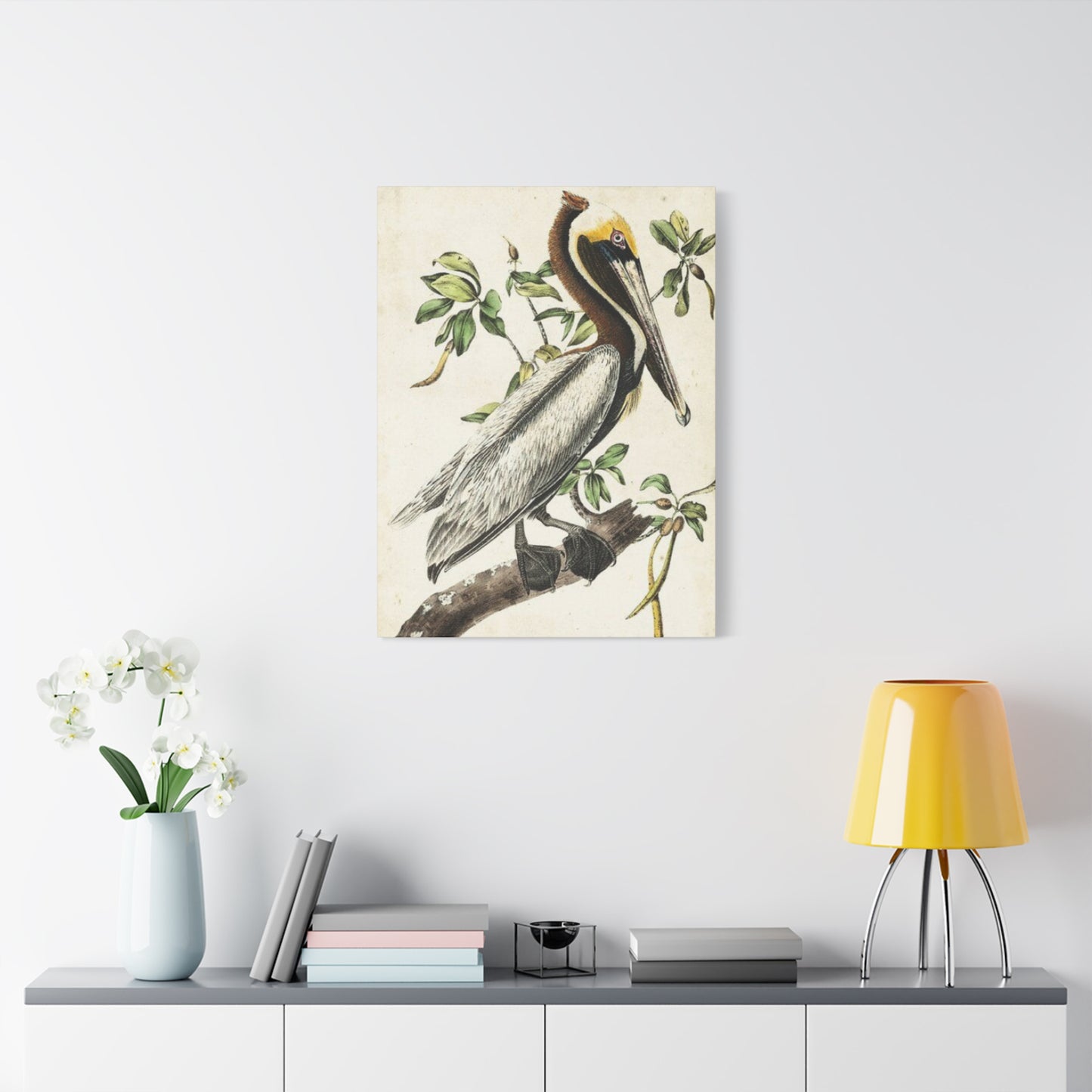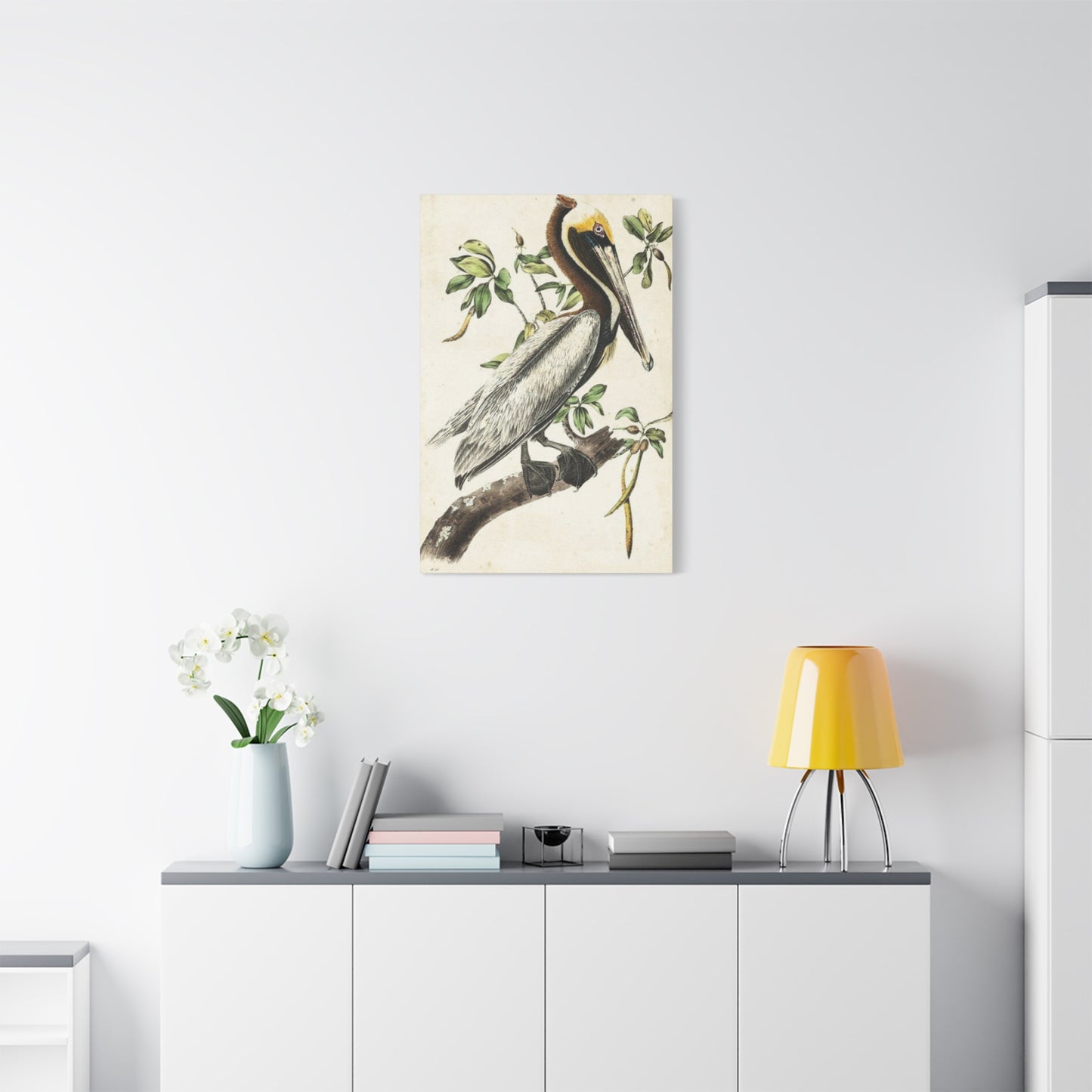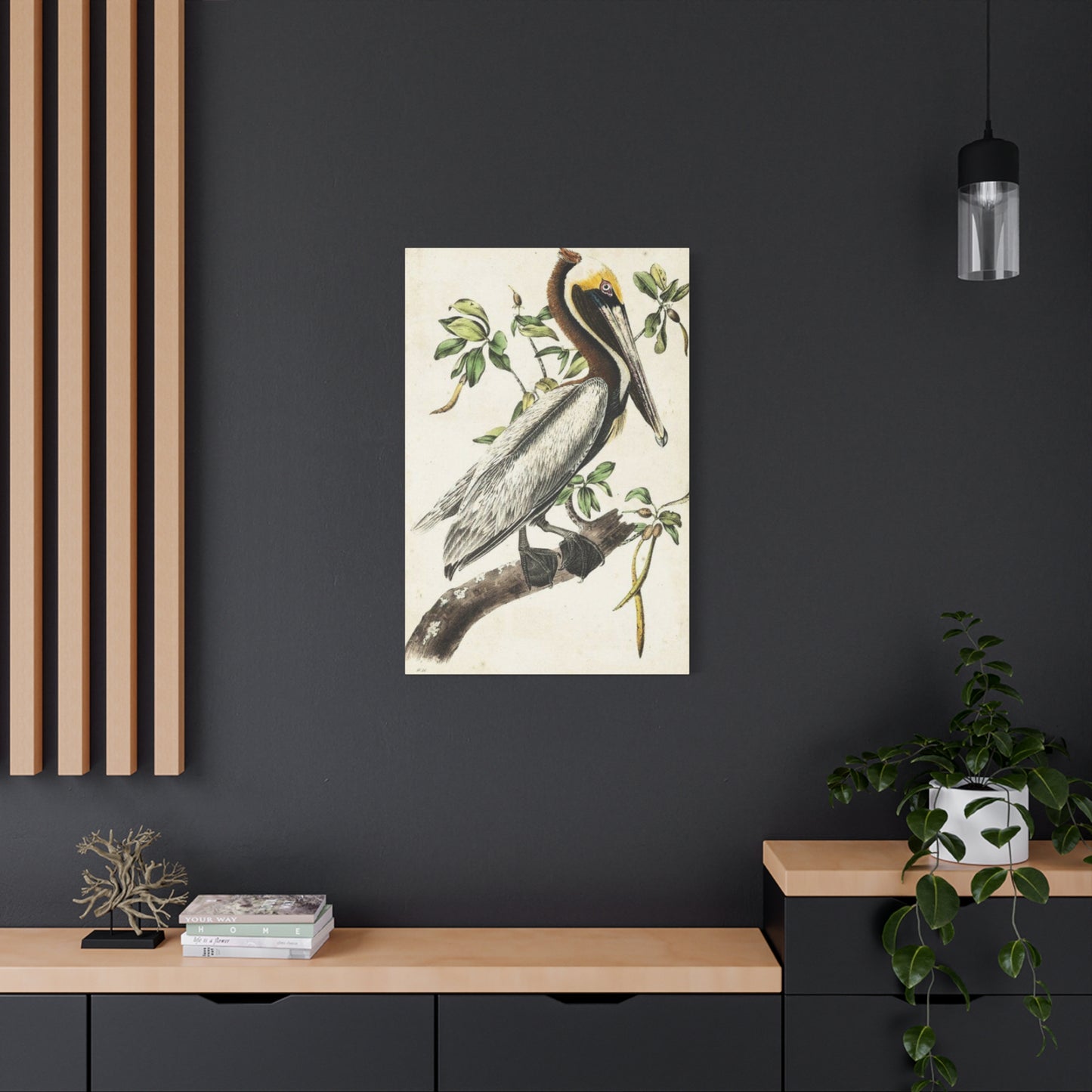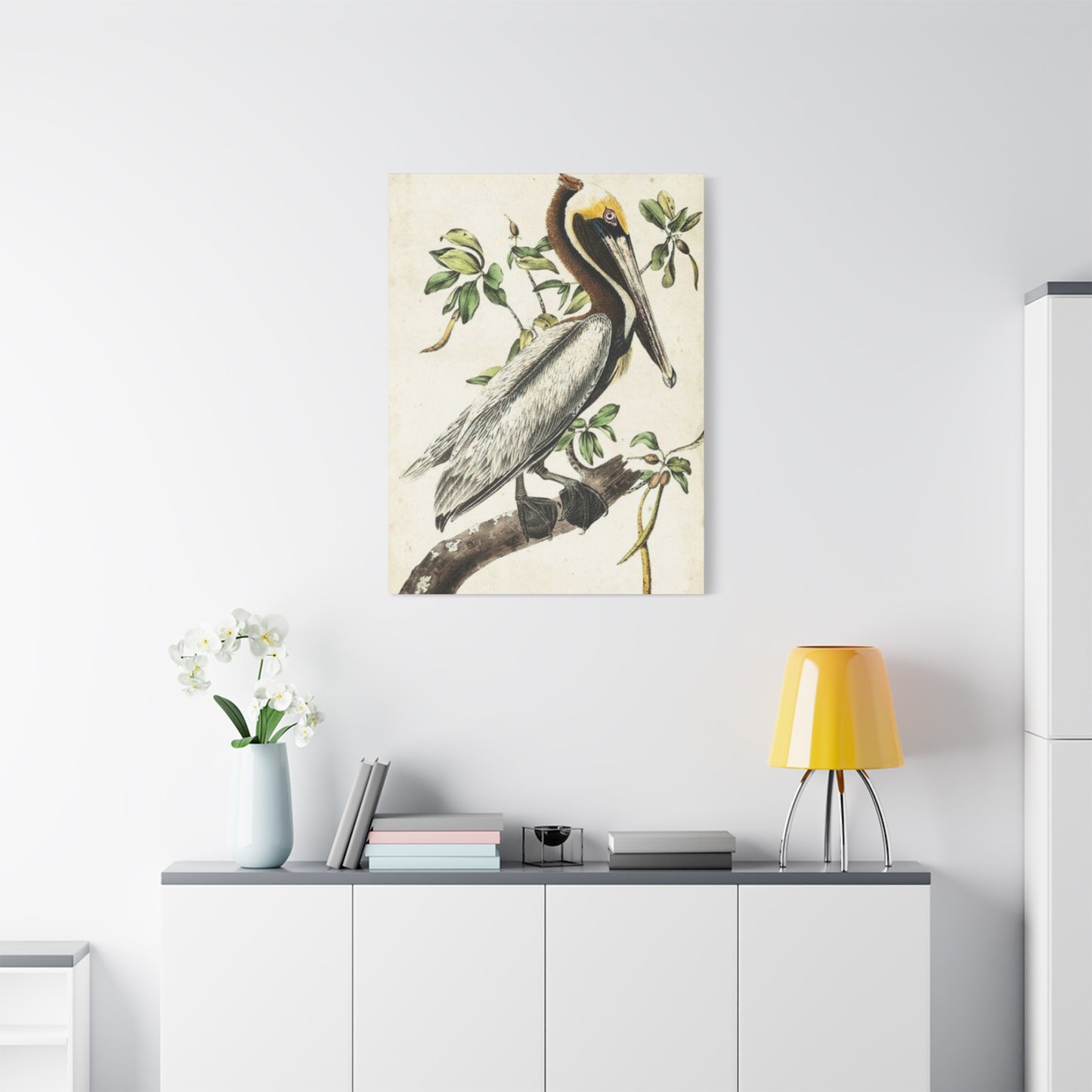Pelican on a Branch Painting Wall Art: Bringing Coastal Elegance to Your Living Space
The world of interior design has witnessed a remarkable surge in nature-inspired artwork, with coastal themes taking center stage in contemporary home decoration. Among these artistic trends, pelican on a branch painting wall art canvas prints have emerged as a sophisticated choice for homeowners and designers seeking to infuse their spaces with a sense of tranquility and natural beauty. These elegant birds, captured in their most serene moments perched upon branches, offer a unique blend of wildlife authenticity and artistic expression that resonates with diverse aesthetic preferences.
Canvas prints featuring pelicans resting on branches represent more than mere decorative elements. They embody a connection to coastal ecosystems, marine life appreciation, and the peaceful coexistence of nature's creatures within their habitats. The growing popularity of such artwork stems from society's increasing awareness of environmental conservation and a collective yearning to bring elements of the natural world into urban living spaces. As people spend more time indoors, the psychological benefits of surrounding oneself with nature-inspired imagery have become increasingly recognized by both design professionals and health experts.
The artistic representation of pelicans on branches captures a moment of stillness that contrasts beautifully with our fast-paced modern lives. These birds, known for their impressive fishing abilities and distinctive appearances, take on a different character when depicted at rest. The imagery invites viewers to pause, reflect, and appreciate the simple beauty of wildlife in its natural state. Whether rendered in realistic detail or interpreted through abstract artistic lenses, these canvas prints serve as windows to coastal environments, bringing the essence of seaside living to any interior space.
Historical Significance of Pelicans in Art and Culture
Throughout human history, pelicans have held symbolic importance across various civilizations and artistic movements. Ancient Egyptian hieroglyphics featured pelican imagery, often associated with nurturing and sacrifice due to the medieval belief that pelicans would pierce their own breasts to feed their young with blood during times of famine. This mythological connection elevated the bird to a symbol of parental devotion and self-sacrifice, themes that resonated deeply within religious and cultural contexts.
In Christian iconography, the pelican became known as the "pelican in her piety," representing Christ's sacrifice and the Eucharist. Medieval and Renaissance artists frequently incorporated pelican symbolism into religious paintings, tapestries, and architectural decorations. This spiritual association gave the bird a revered status that transcended its biological existence, making it a powerful emblem of compassion, renewal, and divine love. The legacy of this symbolism continues to influence contemporary interpretations of pelican artwork, adding layers of meaning beyond the aesthetic appeal.
Native American tribes residing in coastal regions developed their own relationships with pelicans, viewing them as symbols of buoyancy, resourcefulness, and cooperation. These communities observed the birds' fishing techniques and social behaviors, drawing lessons about community support and efficient resource utilization. Pelican imagery appeared in traditional crafts, storytelling, and ceremonial objects, reflecting the bird's integral role in coastal ecosystems and human survival. This cultural heritage has contributed to the modern appreciation of pelican artwork as representations of indigenous wisdom and environmental harmony.
The Romantic and Impressionist movements of the nineteenth century brought renewed attention to wildlife subjects, including pelicans. Artists ventured to coastal regions to capture the interplay of light, water, and avian life, producing works that celebrated the untamed beauty of natural environments. These artistic explorations established precedents for contemporary pelican paintings, emphasizing the importance of observing subjects within their habitats and capturing the atmospheric qualities that define coastal landscapes. The evolution of pelican representation in art reflects changing human relationships with nature, from symbolic abstraction to naturalistic observation and back to stylized interpretation.
Artistic Styles and Interpretations of Pelican Branch Paintings
Contemporary artists approach pelican on a branch subjects through diverse stylistic lenses, each offering unique visual experiences and emotional resonances. Realistic representations aim to capture every feather detail, anatomical accuracy, and the subtle color variations found in pelican plumage. These works appeal to wildlife enthusiasts and collectors who value scientific precision combined with artistic skill. The challenge of realistic pelican portraiture lies in conveying the bird's distinctive features—the massive bill pouch, keen eyes, and robust body structure—while maintaining compositional harmony and aesthetic appeal.
Impressionistic interpretations of pelicans on branches prioritize mood and atmospheric effects over precise details. Artists working in this style use loose brushwork, vibrant color palettes, and emphasis on light quality to evoke the feeling of coastal environments. The pelican becomes a focal point within a broader landscape of suggested forms and color relationships, creating artwork that feels alive with movement and natural energy. This approach resonates with viewers seeking decorative pieces that complement modern interior designs without overwhelming spaces with excessive detail.
Abstract and contemporary styles push pelican imagery into experimental territories, deconstructing the bird's form into geometric shapes, color fields, or symbolic representations. These works appeal to collectors with modern aesthetic sensibilities who appreciate conceptual approaches to wildlife subjects. An abstract pelican on a branch might be represented through bold lines, unexpected color combinations, or fragmented perspectives that challenge traditional wildlife art conventions. Such pieces serve as conversation starters and artistic statements that reflect progressive design philosophies.
Watercolor techniques bring delicate, flowing qualities to pelican branch paintings, with pigment transparency creating ethereal effects that capture the birds' grace. The medium's inherent unpredictability allows for spontaneous artistic moments where paint and water interact in unexpected ways, producing unique textures and color bleeds. Watercolor pelican paintings often convey a sense of lightness and fleeting beauty, making them ideal for spaces designed to promote relaxation and contemplation. The soft edges and luminous qualities characteristic of watercolor work complement coastal and beach-themed interior designs.
Mixed media approaches combine various materials and techniques to create layered, textured pelican artworks. Artists might incorporate collage elements, metallic accents, textural compounds, or digital enhancements to produce pieces with dimensional interest. These innovative works push boundaries of traditional canvas printing, offering collectors unique pieces that stand out as focal points in contemporary interiors. The combination of materials adds complexity and visual intrigue, inviting closer examination and revealing new details with each viewing.
Palette Choices in Pelican Wall Art
The color schemes employed in pelican on a branch canvas prints significantly impact the emotional atmosphere and aesthetic integration within living spaces. Neutral palettes featuring whites, grays, and soft browns create calming, sophisticated environments that complement minimalist and Scandinavian design philosophies. These subdued colorations allow the pelican's form and the branch's structure to serve as primary focal points without competing with surrounding decor. Neutral-toned pelican artwork provides versatility, easily coordinating with various furniture styles and color schemes while maintaining visual interest through tonal variation and compositional strength.
Coastal color palettes incorporating blues, aquas, and sandy beiges directly reference the pelican's natural habitat, reinforcing thematic connections to seaside environments. These color choices evoke feelings of tranquility, openness, and connection to marine ecosystems. Blues range from deep navy tones suggesting ocean depths to pale sky blues that convey airiness and space. When combined with warm sandy hues and weathered wood tones representing branches, these palettes create harmonious compositions that transport viewers to coastal settings. Such artwork functions as visual anchors for beach house themes or as aspirational pieces for urban dwellers dreaming of seaside retreats.
Warm palettes featuring oranges, golds, and russet tones bring energy and vibrancy to pelican branch paintings, often depicting birds during golden hour lighting conditions. These warmer interpretations add richness and depth to interior spaces, creating inviting atmospheres suitable for living rooms, dining areas, and home offices. The contrast between the pelican's lighter plumage and warm background tones creates dynamic visual interest while maintaining the subject's prominence. Warm-toned pelican artwork pairs beautifully with natural wood furnishings, leather accents, and earth-based color schemes prevalent in rustic and traditional interior designs.
Monochromatic approaches utilizing single color families in varying shades and intensities offer sophisticated artistic statements. Black and white pelican paintings emphasize form, contrast, and compositional structure without color distraction. These timeless pieces suit formal settings, modern galleries, and design schemes prioritizing graphic impact over chromatic variation. The absence of color forces viewers to engage with the artwork's fundamental elements—line quality, tonal relationships, and spatial dynamics—resulting in pieces with lasting visual appeal that transcend temporary color trend cycles.
Bold, unexpected color choices in contemporary pelican artwork challenge conventional wildlife art expectations, appealing to adventurous collectors seeking unique statement pieces. Artists might render pelicans in jewel tones, neon hues, or unconventional color combinations that prioritize artistic expression over naturalistic representation. These daring interpretations inject personality and creative energy into spaces, functioning as artistic focal points that reflect owner's individualistic tastes. While such pieces require careful consideration in terms of interior coordination, they reward bold design choices with memorable, conversation-worthy visual impact.
Compositional Elements and Visual Balance in Branch Paintings
The arrangement of elements within pelican on a branch canvas prints determines the artwork's visual flow and emotional impact. Asymmetrical compositions position the pelican off-center, creating dynamic tension and leading the viewer's eye through the pictorial space. This approach aligns with classical compositional principles like the rule of thirds, where subjects placed at intersection points create more engaging images than centered placements. Asymmetry introduces movement and narrative potential, suggesting the pelican might fly away or that the viewer has captured a candid moment in the bird's daily routine.
Centered, symmetrical compositions convey stability, formality, and timelessness. When a pelican occupies the central position on its branch perch, the resulting image projects strength and presence. This compositional choice suits formal interior settings where balanced, authoritative artwork complements architectural symmetry and traditional furnishing arrangements. Symmetrical pelican paintings work particularly well in spaces with centered furniture layouts or architectural features like fireplaces and built-in shelving that benefit from visually weighted focal points.
Vertical compositions emphasizing the branch's upward reach or the pelican's elongated posture create impressions of growth, aspiration, and spatial extension. These tall, narrow canvas formats suit specific architectural contexts like narrow wall spaces, hallways, and areas flanking windows or doors. Vertical pelican artwork draws the eye upward, potentially making rooms feel taller and more spacious. The format also naturally accommodates the pelican's body proportions when depicted in alert, upright postures, creating cohesive relationships between subject matter and presentation format.
Horizontal compositions spreading across wider canvas formats emphasize expansiveness, tranquility, and landscape integration. These broader presentations often include more environmental context—additional branches, foliage, water elements, or sky—creating narrative richness around the pelican subject. Horizontal formats suit installation above sofas, beds, and long furniture pieces where width harmonizes with underlying furnishings. The extended format allows artists to develop atmospheric depth and contextual details that transform simple bird portraits into immersive environmental scenes.
Diagonal compositional elements introduce energy and movement through implied lines created by branch angles, pelican gaze direction, or environmental features. Diagonals create visual pathways that guide viewer attention while suggesting action or potential movement. A branch extending diagonally across the canvas creates inherent dynamism that contrasts with the pelican's stillness, producing tension between stability and motion. This compositional strategy keeps artwork engaging over time, as the internal visual conflicts prevent static, unchanging viewing experiences.
Canvas Print Quality and Production Techniques
Modern canvas printing technology has revolutionized accessibility to high-quality pelican artwork, enabling reproduction of original paintings with remarkable fidelity. Giclée printing processes use archival-quality inks and high-resolution imaging to produce museum-grade reproductions that capture subtle color gradations, texture details, and tonal nuances. The term giclée derives from French, meaning "to spray," referencing the inkjet technology that deposits microscopic ink droplets with precision. This method produces prints with color accuracy and longevity far superior to traditional poster printing, making canvas reproductions legitimate collectible artworks rather than mere decorative accessories.
Canvas materials vary in texture, weight, and weave patterns, each affecting the final artwork's appearance and durability. Artist-grade canvases feature tight, even weaves that accept ink uniformly, preventing distortion and ensuring sharp image reproduction. Cotton and polyester blends offer durability and resistance to environmental factors like humidity and temperature fluctuation, important considerations for artwork longevity. The canvas texture—from smooth to heavily textured surfaces—adds dimensional interest that flat paper prints cannot replicate, creating visual and tactile appeal that enhances the artwork's presence in physical spaces.
Stretching and gallery wrapping techniques determine how canvas prints present on walls. Gallery wrap construction extends the printed image around frame edges, eliminating the need for additional framing and creating clean, contemporary presentations. This approach showcases the artwork itself without decorative frame interference, suiting modern interior aesthetics. Alternative stretching methods incorporate mirror edges where image borders reflect onto frame sides, maintaining compositional integrity on front-facing surfaces. Traditional stretching with subsequent custom framing offers additional protection and decorative enhancement, particularly for formal settings where framed presentations align with established decor conventions.
Protective coating applications enhance canvas print durability and color preservation. UV-resistant varnishes shield artwork from sunlight degradation, a critical consideration for pieces displayed in bright rooms or near windows. These protective layers also facilitate cleaning, allowing dust removal without damaging printed surfaces. Matte, satin, and gloss coating options affect light reflection and visual texture, with matte finishes reducing glare and gloss coatings intensifying color vibrancy. The coating choice influences how artwork appears under different lighting conditions, an important factor when selecting pieces for specific room environments.
Limited edition canvas prints occupy a middle ground between mass-produced reproductions and original artworks. Artists or publishers create numbered print runs, each accompanied by certificates of authenticity that document edition size and print number. This exclusivity adds collectible value and investment potential while maintaining relative affordability compared to original paintings. Limited editions appeal to collectors who value rarity and authenticity but work within budget constraints that preclude acquiring unique original works. The numbered edition structure creates artificial scarcity that enhances perceived value and owner pride in possessing one of limited available copies.
Framing Options and Presentation Styles
While many canvas prints feature gallery-wrapped presentation requiring no additional framing, traditional frame additions offer protective and aesthetic benefits. Wood frames in natural finishes complement coastal themes inherent in pelican branch imagery, with driftwood-style frames particularly reinforcing seaside connections. Darker woods like walnut and espresso create formal, sophisticated presentations suitable for traditional interiors, while lighter woods such as oak and maple maintain contemporary, airy feels. Frame width affects artwork presence, with wider moldings creating substantial, gallery-quality presentations and narrow frames offering subtle definition without competing with the artwork itself.
Metal frames bring contemporary industrial aesthetics to pelican canvas prints, with finishes ranging from brushed aluminum and stainless steel to antiqued bronze and matte black. Metal framing suits modern, minimalist interiors where clean lines and refined materials dominate design vocabularies. The material contrast between organic pelican imagery and industrial framing creates interesting juxtapositions that appeal to eclectic design sensibilities. Metal frames also offer durability advantages, resisting warping and environmental damage better than wood alternatives, important considerations for high-humidity environments like coastal homes.
Floating frame systems create dimensional presentations where canvas appears suspended within frame structures, with visible gaps between artwork edges and frame interiors. This contemporary framing approach adds depth and shadow play that enhances visual interest from oblique viewing angles. Floating frames suit modern and transitional interiors where innovative presentation techniques align with forward-thinking design philosophies. The shadow box effect created by frame depth adds architectural dimension to flat walls, transforming artwork into sculptural elements within three-dimensional spaces.
Matting applications between artwork and frames introduce color coordination opportunities and visual breathing room. While traditional matting suits paper prints, specialized techniques adapt matting for canvas presentations, creating layered effects that add formality and refinement. Mats in neutral tones expand perceived artwork size while providing color transition between canvas and frame. Colored or textured mats introduce additional design elements that can coordinate with room color schemes or emphasize specific artwork hues. However, matting adds expense and complexity, making it more suitable for investment pieces than casual decorative prints.
Frameless presentation embraces canvas prints' inherent qualities, allowing artwork to stand independently without decorative additions. This minimalist approach suits contemporary interiors prioritizing simplicity and content over ornamentation. Gallery-wrapped edges become visible design elements, with print-wrapped edges presenting seamless continuity or mirror-edge techniques maintaining front-facing image integrity. Frameless presentations offer practical advantages including lighter weight, easier installation, and cost savings that allow budget allocation toward larger or higher-quality prints rather than framing expenses.
Integration with Coastal and Beach House Interior Themes
Pelican on a branch canvas prints naturally align with coastal interior design themes that celebrate seaside living and marine environments. These decorative schemes employ color palettes drawn from beaches and oceans—sandy neutrals, seafoam greens, coral accents, and various blue tones from pale sky to deep navy. Pelican artwork reinforces thematic consistency while introducing wildlife elements that personalize generic beach themes. The paintings serve as focal points around which additional coastal decor elements coordinate, including rope accents, weathered wood furnishings, shell collections, and nautical accessories.
Beach house interiors benefit from pelican artwork's ability to establish regional authenticity and environmental specificity. Unlike generic seashell or anchor motifs, pelican imagery references actual coastal ecosystem residents, lending credibility and educational value to decorative schemes. For vacation properties and coastal residences, local pelican species representation creates meaningful connections to surrounding environments, transforming artwork from mere decoration to environmental documentation. Guests and residents gain appreciation for regional wildlife through daily exposure to accurate, artistically rendered pelican portraits.
Layering pelican canvas prints with complementary coastal elements creates cohesive, professionally designed interiors. Coordination with natural fiber textiles like jute, sisal, and linen reinforces organic themes while introducing texture variety. Weathered wood furnishings and driftwood accessories echo branch elements within pelican paintings, creating visual continuity across decorative layers. Glass and ceramic accessories in coastal colors provide opportunities to repeat hues from canvas prints throughout spaces, building color relationships that unify disparate elements into harmonious wholes.
Lighting design significantly impacts how pelican artwork functions within coastal interiors. Natural light streaming through large windows—characteristic of beach house architecture—creates dynamic viewing conditions where artwork appearance shifts throughout daylight hours. Supplementary lighting including picture lights, track lighting, and strategically placed lamps ensures adequate illumination during evening hours while creating ambiance. Lighting direction affects how canvas textures and paint qualities appear, with angled lighting emphasizing dimensional aspects and even lighting focusing attention on color and composition.
Balancing themed decor with sophistication prevents coastal interiors from appearing kitschy or overly literal. Pelican canvas prints in refined artistic styles elevate beach themes beyond novelty territory into serious design statements. Restraint in accessory quantities and quality focus over quantity accumulation maintains elegant atmospheres. Mixing coastal elements with unexpected touches—modern furniture, contemporary lighting, abstract art alongside representational pelican paintings—creates layered, interesting spaces that feel collected and evolved rather than theme-packaged. This design maturity allows coastal themes to appeal to diverse aesthetic preferences and age demographics.
Regional Variations in Coastal Decor Preferences and Styles
Mediterranean coastal design aesthetics differ substantially from Caribbean, Pacific, or Atlantic coastal themes, influencing pelican artwork selection and styling. Mediterranean approaches emphasize warm earth tones, textured plaster walls, wrought iron elements, and rustic wood furnishings. Pelican paintings for these settings often feature warmer color palettes, classical artistic techniques, and European art historical references. The overall effect evokes Old World sophistication and timeless coastal elegance rather than casual beach cottage informality.
Caribbean coastal styles embrace vibrant colors, tropical influences, and relaxed atmospheres reflecting island cultures. Pelican artwork for Caribbean themes might incorporate bright backgrounds, tropical foliage, and color intensities matching the region's vivid natural palette. Artistic styles tend toward looser, more expressive techniques that capture Caribbean energy and light quality. Furniture pieces in light woods, outdoor wicker brought indoors, and tropical plant displays complement pelican paintings within these exuberant design contexts.
Pacific coastal aesthetics, particularly in regions like California and the Pacific Northwest, often emphasize natural materials, Asian influences, and contemporary minimalism. Pelican canvas prints for these markets favor clean compositions, sophisticated color restraint, and modern artistic approaches. The design philosophy prioritizes quality over quantity, with carefully selected pieces making strong statements within uncluttered spaces. Natural wood tones, stone elements, and abundant natural light characterize interiors where pelican artwork serves as refined focal points rather than decorative abundance.
New England coastal themes traditionally embrace nautical history, maritime heritage, and colonial architectural influences. Pelican paintings for these contexts might incorporate more formal compositions, traditional framing, and color palettes emphasizing navy, white, and red. Antique furniture pieces, ship models, historical maritime artifacts, and classic stripe patterns create settings where pelican artwork connects to broader nautical narratives. This regional style values authenticity, craftsmanship, and historical continuity more than trend-following innovation.
Southern coastal states combine elements from various traditions including Spanish colonial influences, African American Gullah culture, and antebellum architectural heritage. Pelican artwork for these markets may incorporate these diverse cultural threads through artistic style choices, color palette selections, and compositional approaches. Interiors might mix antique pieces with contemporary elements, bold colors with neutral foundations, and formal arrangements with relaxed comfort. This eclectic Southern coastal aesthetic welcomes pelican paintings that balance sophistication with approachability.
Gift Giving and Special Occasion Uses for Pelican Canvas Prints
Pelican on a branch canvas prints make meaningful gifts for various special occasions, particularly when recipients have coastal connections or wildlife interests. Housewarming gifts featuring pelican artwork help new homeowners establish decorative schemes while demonstrating gift giver thoughtfulness about recipient tastes. Selecting artwork that coordinates with known color preferences or room functions shows extra consideration that recipients appreciate. Quality canvas prints represent substantial gifts appropriate for significant relationships and milestone occasions, conveying respect and care through both monetary investment and aesthetic selection effort.
Wedding and anniversary gifts benefit from pelican artwork's symbolic associations with partnership and provision. Pelican couples depicted together symbolize partnership, while the birds' legendary devotion to offspring metaphorically represents family commitment. Personalization through custom commissioning, selecting artwork depicting locations significant to couples, or pairing prints with meaningful inscriptions increases sentimental value. Canvas art gifts provide lasting presence in recipients' homes, regularly reminding them of gift givers and celebrated occasions long after consumable gifts are forgotten.
Retirement gifts marking career conclusions and new life chapter beginnings find appropriate expression through pelican canvas prints. The imagery suggests freedom, leisure, and connection to nature that many retirees prioritize after career demands conclude. Coastal artwork particularly suits retirees relocating to beach communities or those who dream of seaside living. The gift acknowledges recipient contributions while looking forward to relaxed futures, balancing gratitude for past accomplishments with excitement about coming adventures.
Memorial and sympathy gifts require careful consideration, though nature imagery including pelican paintings offers appropriate comfort symbolism. Birds generally represent spiritual transcendence and continuation beyond physical existence across many belief systems. Pelican artwork's peaceful qualities provide meditation focal points supporting grief processing without overwhelming mourners with explicitly religious imagery that might not align with beliefs. Selecting subdued color palettes and serene compositions ensures appropriateness for sensitive contexts while offering beauty that comforts during difficult periods.
Corporate gifts demonstrate professionalism and thoughtfulness when selected appropriately for recipient interests and office contexts. Pelican canvas prints suit businesses with coastal locations, environmental focuses, or outdoor recreation industries. Quality artwork signals respect for recipient status while avoiding generic gift impersonality. Including artist information, print specifications, and care instructions adds educational value while demonstrating gift giver sophistication. Corporate art gifts create lasting impressions that calendars and gift baskets cannot match, maintaining gift giver presence through years of office display.
Pelican Artwork in Different Architectural Styles and Home Types
Modern architectural contexts emphasizing clean lines, open spaces, and minimal ornamentation require carefully selected pelican canvas prints that complement rather than conflict with design philosophies. Contemporary pelican artwork in abstract or stylized interpretations suits modern interiors better than highly detailed realistic renderings. Large-scale prints make bold statements appropriate for expansive walls characteristic of modern design, while color restraint maintains visual calm. Frameless gallery-wrapped presentations align with modern minimalism, eliminating decorative elements that might introduce visual clutter into deliberately simplified spaces.
Traditional home architecture featuring formal room arrangements, classical proportions, and historical references accommodates pelican artwork through thoughtful presentation and framing choices. Realistic pelican paintings in substantial wood frames coordinate with traditional furnishing styles and architectural detailing. Formal hanging arrangements following symmetrical principles suit traditional aesthetic values, with paired artworks flanking architectural features or centered above furniture pieces. Color palettes drawing from historical precedents rather than contemporary trends ensure pelican artwork feels appropriate within traditional contexts rather than appearing anachronistically modern.
Farmhouse and rustic architectural styles characterized by exposed beams, natural materials, and comfortable informality welcome pelican canvas prints that emphasize organic textures and earthy color palettes. Distressed frame finishes, natural wood tones, and relaxed compositions suit farmhouse aesthetics where perfection takes back seat to warmth and authenticity. Pelican artwork depicting birds in natural, unstaged moments aligns with farmhouse values of honest simplicity. Mixing pelican paintings with other nature subjects including landscapes, botanicals, and farm animals creates layered, collected atmospheres characteristic of successful farmhouse design.
Coastal cottage architecture featuring board-and-batten siding, wide porches, and casual layouts provides natural settings for pelican on a branch canvas prints. These informal structures embrace coastal themes authentically, with pelican artwork reinforcing architectural identity. Whitewashed or light-colored walls characteristic of coastal cottages beautifully showcase artwork without color competition. Multiple smaller pelican prints throughout cottage interiors create thematic consistency while avoiding single focal point formality inappropriate for relaxed cottage atmospheres. The architectural style and artwork subject matter combine seamlessly, each reinforcing the other's coastal authenticity.
Urban loft spaces with industrial elements including exposed brick, metal fixtures, and open floor plans present interesting contrasts for pelican artwork. The juxtaposition between organic wildlife subjects and hard industrial materials creates visual tension that sophisticated designers exploit for dramatic effect. Oversized pelican canvas prints hold their own against lofts' vast wall expanses and high ceilings. Contemporary artistic interpretations bridge gaps between natural subjects and industrial contexts, with bold colors and graphic treatments connecting disparate aesthetic vocabularies. These challenging spaces reward creative design thinking that embraces contrasts rather than demanding perfect stylistic consistency.
Photography vs. Painting in Pelican Canvas Print Production
Photographic pelican canvas prints offer documentary realism capturing actual birds in authentic moments. Wildlife photography requires immense patience, technical skill, and often specialized equipment for distant subject capture. The resulting images provide windows into pelican lives, showing genuine behaviors, natural lighting, and environmental contexts that paintings cannot match for authenticity. Photographic prints appeal to collectors valuing accuracy and real-world connection over artistic interpretation. Modern printing technology renders photographic details with clarity that rivals original photographs, making canvas photos legitimate art forms rather than mere reproductions.
Painted pelican artwork prioritizes artistic interpretation over documentary accuracy, with artists making intentional choices about color enhancement, compositional adjustments, and atmospheric effects. Paintings transform observed reality through individual artistic vision, creating works that reveal as much about artists as subjects. The visible presence of artistic hand—brushstrokes, texture, color mixing—adds human dimension absent from photographs. Many collectors prefer painted pelican canvases specifically for these interpretive qualities that distinguish art from documentation.
Mixed approaches combining photographic foundations with painted embellishments bridge photography and painting traditions. Artists might begin with photographic references, then paint over or digitally manipulate images to introduce artistic elements. These hybrid works offer photographic realism where desired while incorporating painterly qualities in selective areas. The technique allows artists to achieve realistic accuracy in complex areas like feather details while exercising creative freedom in backgrounds and atmospheric effects. Hybrid approaches expand creative possibilities beyond limitations inherent in purely photographic or painted methods.
Abstract photographic techniques including intentional blur, multiple exposures, and experimental processing transform pelican subjects into artistic expressions rather than documentary records. These approaches use photographic equipment but pursue painterly aesthetic effects, challenging distinctions between media. Abstract photographic pelican prints appeal to collectors seeking contemporary art that references natural subjects without literal representation. The techniques demonstrate photography's artistic potential beyond documentary roles, legitimizing the medium as fine art comparable to traditional painting.
Digital painting technologies allow artists to create painted-appearance pelican artwork without physical paint or brushes. Working entirely digitally, artists achieve painterly effects through software mimicking traditional media behaviors. Digital paintings printed on canvas closely resemble traditional paintings while offering advantages including unlimited revision possibilities and no drying time constraints. Debates continue about whether digital paintings equal traditional works artistically, though technical skill requirements remain substantial regardless of tools. Many contemporary artists seamlessly blend digital and traditional techniques, making rigid categorical distinctions increasingly meaningless.
Installation Techniques and Professional Hanging Services
Proper canvas print installation ensures secure mounting, correct positioning, and wall protection. Wall material considerations affect hardware selection, with drywall, plaster, brick, and concrete each requiring specific fastening approaches. Stud finding using electronic detectors or manual tapping locates solid mounting points within stud-framed walls. Hanging heavier pelican canvases directly into studs provides maximum security, while lighter pieces can safely use drywall anchors rated for appropriate weights. Understanding weight distribution prevents installation failures that damage both artwork and walls.
Hardware options for canvas hanging include traditional picture hooks, modern hanging systems, and specialized canvas hangers. D-rings attached to frame backs work with corresponding wall hooks, creating secure connections that prevent artwork from shifting. Wire hanging systems allow horizontal position adjustments after installation, providing flexibility for achieving level display. French cleat systems distribute weight across longer wall contact areas, offering superior security for heavy or valuable pieces. Choosing appropriate hardware for specific artwork and walls ensures safe, stable display that withstands years of environmental stresses.
Level alignment significantly affects professional installation appearance, requiring careful measurement and adjustment. Bubble levels and laser levels ensure horizontal accuracy, preventing crooked displays that undermine even quality artwork. Measuring from consistent reference points like ceiling lines or floor levels creates uniform positioning when installing multiple pieces. Marking desired positions with removable tape or pencil allows visualization before permanent installation. These preparation steps prevent costly mistakes and wall damage from multiple repositioning attempts.
Professional art installation services provide expertise valuable for expensive artwork, challenging spaces, or complex arrangements. Installers bring specialized tools, mounting hardware knowledge, and experience preventing common amateur mistakes. Services often include site assessment, hardware recommendations, and precise positioning according to design principles. The cost typically justifies peace of mind for valuable pieces where installation errors could cause damage. Professional services also relieve homeowners of physical demands and liability associated with ladder work and wall modification.
Gallery wall layout services assist with multi-piece arrangements where compositional complexity overwhelms DIY attempts. Professionals create paper templates showing exact positioning for multiple artworks, simplifying execution while ensuring attractive results. Some services use specialized software generating layouts based on available artwork and wall dimensions. These planning tools eliminate guesswork and prevent the disappointing results that often result from improvised arrangements. Investment in layout services pays dividends through professional appearances that enhance artwork impact and owner satisfaction.
Height considerations affect viewing comfort and artwork visibility. General guidelines suggest artwork centers position at approximately 57 to 60 inches from floor level, approximating average eye height for standing viewers. However, context adjustments account for ceiling height, surrounding furniture, and viewer position. Artwork above sofas typically hangs lower for comfortable viewing from seated positions, while hallway pieces might hang higher to remain visible above heads in traffic areas. Flexible positioning according to specific contexts prevents rigid adherence to general rules that may not suit particular situations.
Removable hanging solutions accommodate renters and those avoiding permanent wall alterations. Command strips rated for appropriate weights provide damage-free alternatives to nails and screws, though weight limitations restrict options for larger canvases. Picture hanging systems with ceiling-mounted tracks offer extremely flexible arrangements without wall penetration. Easel displays work for smaller canvases, allowing floor or furniture surface placement without any wall attachment. These alternative approaches maintain flexibility while displaying artwork attractively, though security and stability generally remain inferior to traditional wall mounting.
Collecting Strategies for Building Pelican Art Collections
Thematic collecting approaches focus acquisitions around specific subjects, creating cohesive collections with clear identities. A pelican-focused collection might include various artistic styles, different species, or diverse compositional approaches while maintaining subject consistency. Thematic collections tell visual stories about collector interests and values, creating more significant whole impressions than random assemblages. Building collections gradually allows financial spreading while creating enjoyable long-term pursuits. Documentation including purchase information, artist biographies, and edition details adds scholarly dimension to collecting activities.
Investment collecting requires research, market knowledge, and relationship building with galleries and artists. Identifying emerging wildlife artists before widespread recognition offers acquisition opportunities at lower prices with appreciation potential. Following auction results, gallery exhibitions, and critical reviews builds market understanding. Developing relationships with reputable dealers provides access to quality works and expert guidance. However, art investment carries risks including market volatility and subjective value assessments, making purchases based purely on aesthetic appreciation generally safer emotional and financial strategies.
Eclectic collecting embraces diversity, mixing pelican canvases with unrelated subjects, styles, and media. This approach prioritizes personal response over rigid collecting criteria, resulting in unique assemblages reflecting collector personality evolution. Eclectic collections suit informal display settings where variety creates visual interest rather than appearing chaotic. The strategy allows impulse purchases when encountering irresistible pieces regardless of how they fit existing collections. This flexibility prevents missing opportunities due to overly restrictive collecting criteria while maintaining enjoyment and spontaneity.
Condition assessment skills help collectors evaluate quality and detect restoration or damage affecting value. Examining canvases for color fading, canvas deterioration, frame damage, and moisture issues prevents purchasing compromised pieces. Comparing multiple examples develops eye for quality distinctions that aren't immediately obvious to inexperienced collectors. Requesting detailed photographs showing close-up details assists remote purchasing decisions when in-person inspection isn't possible. Understanding condition's impact on value enables negotiation and prevents overpaying for damaged works.
Provenance documentation tracing artwork ownership history adds value and authenticity assurance. Original purchase receipts, exhibition histories, and previous owner records create provenance chains that verify authenticity and establish collecting pedigrees. Limited edition prints should include certificates of authenticity showing edition numbers and artist signatures or publisher marks. Maintaining comprehensive records protects collector investments while potentially enhancing resale values. Digital documentation including photographs and condition reports creates backup records preventing loss of paper documentation.
Creating Cohesive Color Schemes Around Pelican Artwork
Monochromatic color schemes built around single hues appearing in pelican canvas prints create sophisticated, harmonious interiors. Selecting a dominant color from artwork—perhaps blue from sky or water elements—then using various tints, shades, and tones throughout space creates subtle variation within unified palettes. Monochromatic approaches feel calm and intentional, avoiding color conflict risks inherent in multi-hue schemes. However, tonal variety prevents monotony, with lighter and darker value ranges adding depth and visual interest. Texture variation becomes particularly important in monochromatic schemes to maintain engagement without color diversity.
Analogous color schemes use adjacent color wheel colors appearing in pelican artwork for harmonious coordination. If artwork features blues and greens characteristic of coastal settings, surrounding decor might incorporate blue-greens, teals, and aquas. These closely related colors create peaceful, cohesive environments without dramatic contrasts. Analogous schemes feel natural because they mirror color relationships observed in nature, where smooth gradations rather than sharp contrasts typically occur. The approach offers more variety than monochromatic schemes while maintaining harmony and coordination.
Complementary color schemes pair opposite color wheel colors for dynamic, energetic effects. Orange and blue, common in pelican artwork depicting birds against sunset or ocean backgrounds, create vibrant combinations when repeated in room decor. Complementary schemes demand careful balance to avoid overwhelming spaces with color intensity. Using one color dominantly with complementary accents typically succeeds better than equal color distribution. Neutral elements buffer between complementary colors, preventing jarring transitions while allowing each color to enhance the other through contrast.
Triadic color schemes incorporate three equally spaced color wheel positions, creating balanced yet varied palettes. Pelican artwork featuring blues, yellows, and reds could inspire triadic room schemes using these colors in different proportions and intensities. The approach offers diversity while maintaining color theory foundations ensuring harmony. Triadic schemes feel lively and optimistic, suitable for social spaces like living rooms and dining areas where energy and conversation are encouraged. Careful proportion management prevents chaos, with one color dominating while others serve accent roles.
Neutral color schemes with artwork providing sole color accent create flexible, timeless interiors. When surrounding environments feature whites, grays, beiges, and browns, pelican canvas prints with color become dramatic focal points. This approach allows artwork regular rotation without requiring entire room redecoration, as neutral foundations accept various accent colors. The strategy prioritizes artwork prominence, ensuring nothing competes for visual attention. Neutral schemes appeal to minimalists and those who tire quickly of bold color commitments, offering changeability within stable foundational palettes.
Working with Interior Designers on Pelican Art Selection
Interior designer collaboration brings professional expertise to artwork selection and placement decisions. Designers understand space proportions, color theory, lighting effects, and style integration in ways exceeding typical homeowner knowledge. They access trade resources including artist studios, wholesale galleries, and custom production facilities unavailable to retail consumers. Designer relationships with artists and vendors often secure preferential pricing or custom work opportunities. While design services add costs, the value delivered through avoided mistakes and optimized results often justifies expenses.
Design consultation processes typically begin with space assessment including measurements, lighting analysis, and existing decor evaluation. Designers photograph spaces and create mood boards showing proposed design directions including artwork possibilities. Client interviews explore preferences, lifestyles, and functional requirements informing recommendations. When pelican artwork fits established design directions, designers source options matching specifications. Presentation of multiple choices with professional reasoning behind each selection helps clients make informed decisions aligned with overall design visions.
Budget discussions establish realistic expectations about quality and options within financial parameters. Designers explain how different price points affect artwork longevity, visual impact, and investment value. They might suggest phased acquisition approaches where priority pieces purchase immediately while others await future budgets. Creative solutions including reproduction prints of expensive originals or emerging artist works provide budget-conscious alternatives to established artist pieces. Transparent budget conversations prevent disappointment while maximizing value extraction from available resources.
Custom commissioning through designer relationships provides access to artists and streamlined project management. Designers handle artist communications, contract negotiations, timeline management, and quality control, relieving clients of coordination burdens. Their experience prevents common commissioning pitfalls including unclear expectations, timeline disputes, and unsatisfactory results. Designer involvement protects client interests while supporting artist success through clear, professional working relationships. The service value particularly shines in custom work where miscommunication risks exceed ready-made purchase scenarios.
Installation coordination as part of comprehensive design services ensures artwork displays optimally within completed spaces. Designers arrange professional hanging, verify lighting adequacy, and make final positioning adjustments. This holistic approach prevents common scenarios where beautiful artwork disappoints through poor installation. Seeing projects through to completion demonstrates designer commitment to results rather than merely selling products. Ongoing relationships allow future artwork additions coordinating with established designs, building collections cohesively over time.
Conclusion
Incorporating coastal elements into your home décor is a timeless way to create a peaceful and inviting atmosphere, and the Pelican on a Branch painting wall art captures this essence beautifully. With its elegant portrayal of a calm, observant pelican perched in its natural habitat, this artwork brings both tranquility and sophistication to any living space. Whether your home is near the sea or far inland, this piece can transport you to the serene coastal settings that inspire relaxation and reflection.
The pelican, often associated with patience, protection, and grace, serves as a powerful symbol in interior design. Its quiet presence on a branch not only evokes imagery of gentle sea breezes and ocean waves but also adds a subtle narrative of balance and natural beauty. This makes it a versatile piece—one that complements a range of interior styles, from contemporary coastal and rustic nautical to bohemian and even minimalist aesthetics.
Positioning the Pelican on a Branch wall art in your living room, hallway, or bedroom allows the space to benefit from its calming energy and natural elegance. The soft, muted tones typically found in coastal art harmonize well with neutral palettes and natural materials like wood, rattan, and linen, enhancing the relaxed coastal feel without overwhelming the space. This subtle infusion of nature-inspired design helps create a sanctuary-like environment in your home.
Another advantage of choosing this type of wall art is its adaptability. Whether you’re decorating a small apartment, a spacious beach house, or simply a corner of a room that needs a refresh, the pelican painting serves as both a focal point and a grounding element. It offers an easy yet impactful way to shift the mood of a room, all without the need for major renovations or design overhauls.
Art plays a critical role in personalizing our homes and expressing our unique tastes. By selecting a piece like Pelican on a Branch, you're not just filling a wall—you’re telling a story, curating a mood, and connecting with the calming power of the natural world. It’s a reminder of the stillness and beauty found in coastal life, brought right into the heart of your home.
In conclusion, if you're looking to add a touch of coastal elegance that speaks to both style and substance, the Pelican on a Branch painting wall art is an excellent choice. Its visual simplicity and symbolic depth make it a meaningful and stylish addition to any living space—bringing the coast to you, one graceful detail at a time.

















